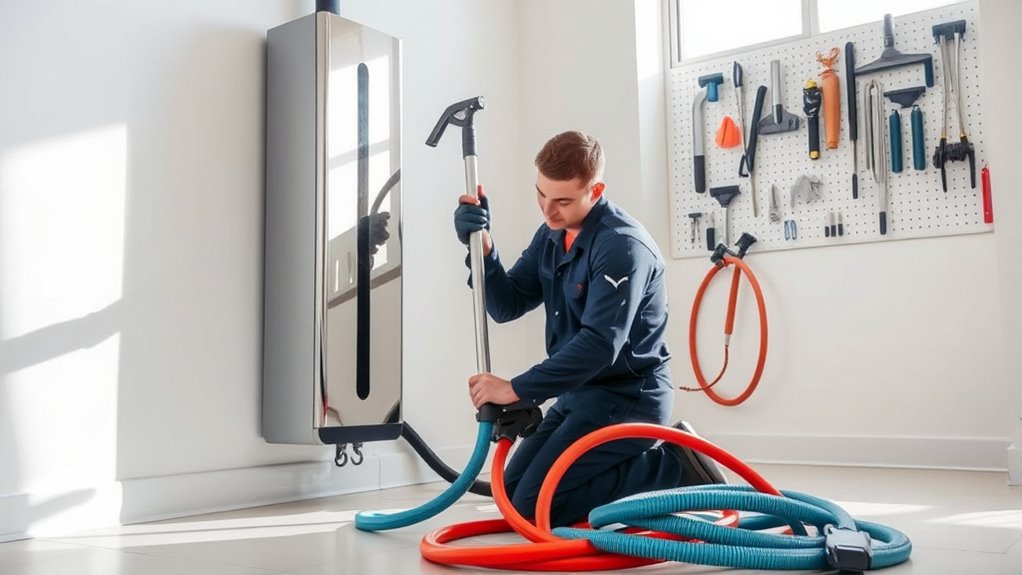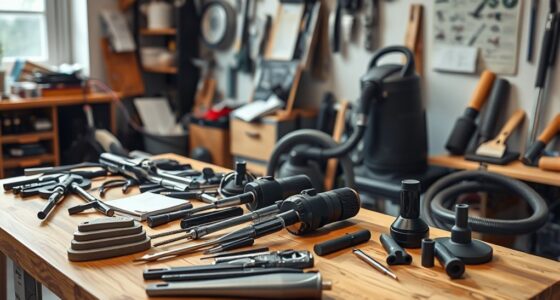To maintain your central vacuum system, replace or clean filters every 6 months to a year. Inspect hoses for cracks and blockages, cleaning them regularly with a brush or wet-dry vacuum. Don’t forget to check inlets and connections for dirt buildup to make sure peak performance. Keeping up with these tasks enhances air quality and system efficiency. Want to know more tips for keeping your system running smoothly?
Key Takeaways
- Regularly replace or clean filters every 6 months to 1 year to maintain suction power and enhance indoor air quality.
- Inspect hoses for cracks, tears, or blockages to prevent motor damage and ensure optimal airflow.
- Clean inlets and connections regularly to avoid dust buildup and maintain system efficiency.
- Use a flexible brush or wet-dry vacuum to remove debris from hoses and prolong their lifespan.
- Follow manufacturer guidelines for maintenance to ensure peak performance and longevity of the system.

When you invest in a central vacuum system, you’re not just enhancing your home’s cleanliness; you’re also committing to its upkeep. To guarantee your system runs efficiently and lasts longer, regular maintenance is essential. The good news is that maintaining a central vacuum system doesn’t have to be an overwhelming task; a few simple steps can go a long way in keeping everything in top shape.
First, let’s talk about filter replacement. Filters play a critical role in capturing dust and allergens, so checking them regularly is a must. Depending on the model and usage frequency, you should replace or clean your filters every six months to a year. If you notice reduced suction power or increased dust in your home, it might be time for a filter change. Not only will this improve your vacuum’s performance, but it’ll also enhance your indoor air quality. Keep an eye out for any discoloration or tears in the filter, as these can indicate that it’s time to replace it. Don’t forget to consult your manufacturer’s guidelines for specific instructions on what type of filter you need.
Regularly check and replace your vacuum filters to maintain performance and improve indoor air quality.
Next on the list is hose inspection. Your vacuum’s hose is its lifeline, so making sure it’s in good condition is essential. Regularly check for cracks, tears, or blockages. A damaged hose can lead to reduced suction and even damage to the motor. If you find any issues, it’s usually best to replace the hose entirely rather than trying to patch it up. When inspecting, also look for any buildup inside the hose that could hinder airflow. A thorough cleaning every few months can keep it functioning at its best. You can use a long, flexible brush or even a wet-dry vacuum to help clear out any debris stuck within.
Lastly, don’t forget to check the connections and inlets around your home. Dust and dirt can accumulate there, impacting performance. Keeping these areas clean will guarantee your central vacuum system operates at peak efficiency. By following these simple maintenance steps, you’re investing in a cleaner, healthier home and prolonging the life of your central vacuum system. Remember, a little attention goes a long way in maintaining your investment!
Frequently Asked Questions
Can I Use My Central Vacuum System for Wet Cleaning?
No, you shouldn’t use your central vacuum system for wet cleaning. These systems are designed for dry debris and can get damaged by moisture. If you attempt wet cleaning, it could lead to costly repairs and maintenance issues. Stick to using your central vacuum for its intended purpose to guarantee it runs efficiently. Regular vacuum maintenance will keep your system in top shape, helping you avoid problems in the future.
How Long Do Central Vacuum Systems Typically Last?
Central vacuum systems typically last between 15 to 25 years. With proper vacuum filter maintenance, you can prolong their lifespan. Regularly clean or replace filters, and keep an eye on the hoses. Store hoses properly to prevent kinking or damage. Treat your system right, and it’ll reward you with years of reliable service. By paying attention to these small details, you guarantee your vacuum remains efficient and effective for a long time.
Is Professional Maintenance Necessary for Central Vacuum Systems?
Yes, professional maintenance is often necessary for central vacuum systems. You’ll benefit from regular professional servicing to guarantee peak performance and longevity. They can handle vacuum filter replacement, which you might overlook or struggle with. Neglecting these tasks can lead to decreased suction and potential damage. By scheduling professional checks, you keep your system running efficiently and extend its lifespan, saving you time and money in the long run.
What Are Signs My Central Vacuum Needs Repairs?
If your central vacuum’s performance dips, it’s time to check for signs it needs repairs. Look for a decrease in suction power, which might indicate a clogged vacuum filter or hose blockage. You may also notice unusual noises or a burning smell, signaling potential motor issues. If you see dust escaping while vacuuming, that’s a clear sign something’s wrong. Address these issues promptly to keep your system running smoothly.
Can I Install a Central Vacuum System Myself?
Yes, you can install a central vacuum system yourself if you’re handy and understand system compatibility. Imagine you’re tackling a DIY installation in your new home, excited to eliminate the hassle of dragging a regular vacuum around. Just make certain the components fit your existing infrastructure, like the electrical and plumbing systems. With careful planning and the right tools, you can save money while enjoying the convenience of a central vacuum in no time!
Conclusion
By staying on top of your central vacuum system’s maintenance, you can guarantee it runs smoothly and efficiently, much like the well-oiled machines of Da Vinci’s inventions. A little regular care goes a long way in preventing costly repairs and extending the life of your system. So, roll up your sleeves, check those filters, and remember: a clean home starts with a clean vacuum. With diligence, you’ll keep your space dust-free and your system humming like a masterpiece.









